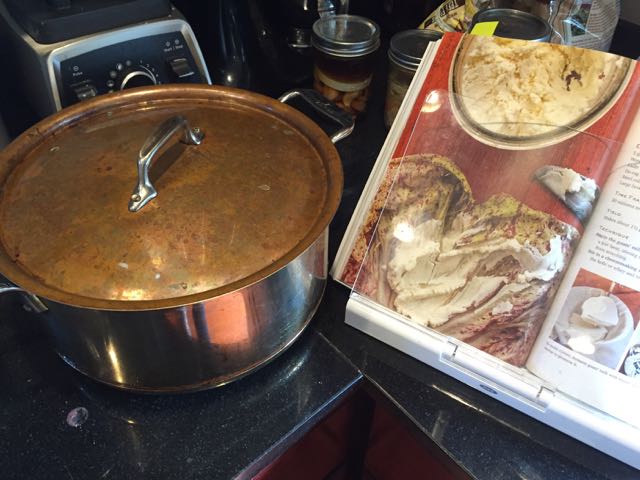Chèvre. Twice.
After listening to David Asher on Cutting the Curd and Fuhmentaboudit!, I was inspired to make his favorite cheese: chèvre. As he promised in The Art of Natural Cheesemaking, this cheese was very straightforward and required very little active time.
Look at this beautiful chèvre! We got about a pound and a half of it, too, which is terrific. We ate it for snack on some crackers, with apples and honey. I also put some into a vegetable frittata for lunch yesterday.
For as simple as this cheese is, would you believe that we may have had another cheese fail along the way? Here's what happened.
On Wednesday, I set up our kefir to culture so we would be ready for cheesemaking on Thursday. Thursday, morning, I went to Rainbow Grocery to buy four quarts of Claravale Raw Goat's milk. The milk was delivered that day. In fact, I had to wait for it to be taken off the truck. I brought the milk straight home, refrigerated it, and after school, Wyatt and I set to work making cheese.
Right away, we noticed an issue. The milk smelled strong. And while the milk didn't taste horrible, it didn't taste good. It had a strongly acidic and goat-y flavor, and there was no way either one of us would have even entertained drinking it. But this was only the fourth time or so that we had purchased goat's milk, and I wondered whether it was just we who had a problem with it. Maybe this milk was within the acceptable range of goat milk flavors. Or maybe the idea of doing another hour-plus round trip to the store with drippy milk bottles was just more than I could handle. We decided to move ahead with the cheese to see what would happen.







As usual, we poured and heated the milk, dissolved the rennet, added the kefir culture, added the rennet, and then left the cheese to ferment. The period for this cheese to ferment is 24 hours at room temperature.




The cheese that resulted was definitely weird. The curd was firm, full of holes and spongy. You could actually wring out the whey from it. It looked nothing like David's photos, and it tasted strong. The flavors were more like the milk had been clabbered, so maybe there was something that had happened with refrigeration during the milk's transit to Rainbow. I emailed Claravale to find out what might have happened, but they never responded. We ate some of the cheese, crumbled on tacos on Friday. None of us suffered any ill effects, but we weren't that eager to eat more of it.
On Saturday, I bought more goat's milk and we tried it again. This time, the milk tasted good and only mildly goat-y. And the curd we achieved looked like David's photos. Even better, the cheese tastes amazing.
I think the (admittedly obvious) lesson I have learned from this recipe is that we should trust our noses and taste buds, regardless of when the milk was delivered. If there's something off with the milk, the cheese will be off, too.
If anyone has any experience with goat's milk and can let me know what may have been wrong with the first batch we tried, I'd love to hear it. Please leave a comment!


